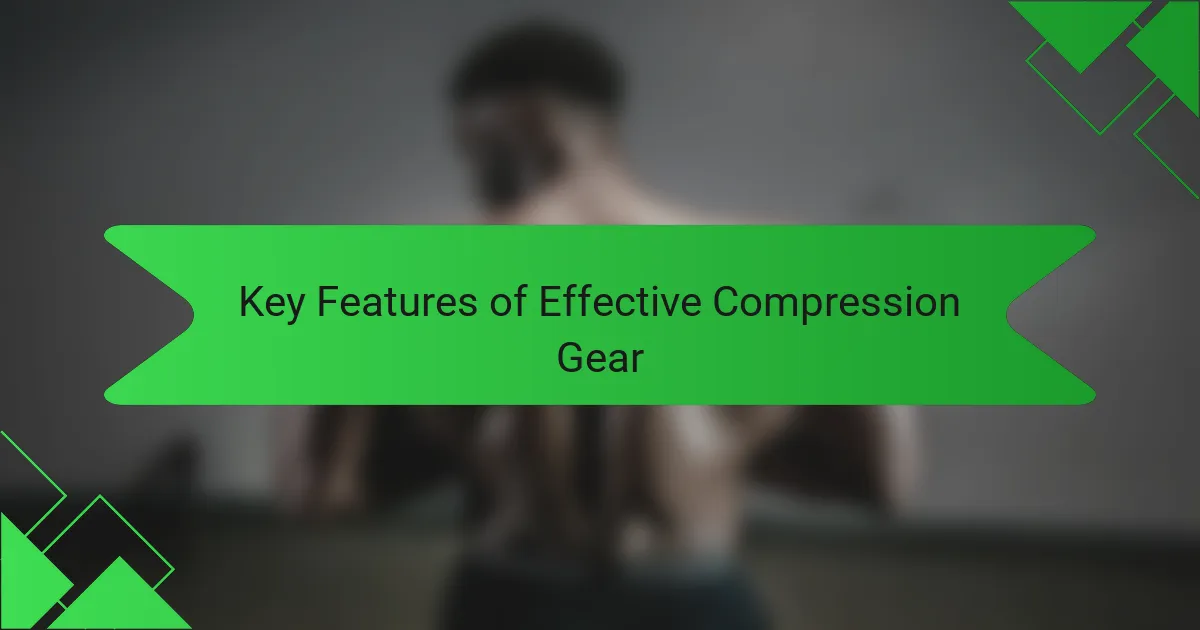Key takeaways
- Compression gear enhances blood circulation, reducing muscle soreness and speeding up recovery post-race.
- Key features for effective compression gear include graduated compression, breathable fabric, and a comfortable fit for optimal support.
- Combining compression with hydration and gentle stretching significantly improves recovery outcomes.
- Consistency in using compression gear immediately after races can act as a protective measure against inflammation and fatigue.

Understanding Compression Gear Benefits
Compression gear has been a game-changer for me in obstacle course racing recovery. I noticed that after intense races, wearing compression sleeves helped reduce the soreness in my calves much faster than just resting. It feels like they gently support the muscles, allowing me to bounce back quicker for the next training session.
From my experience, compression clothing isn’t just about feeling tight; it actively promotes better blood flow, which is crucial when your muscles are fatigued. Here’s what I found most beneficial:
- Enhances circulation, speeding up the removal of metabolic waste
- Reduces muscle vibration, minimizing soreness and damage
- Provides additional support to joints and muscles during recovery
- Helps maintain warmth, preventing stiffness after a race
- Can improve proprioception, making movements feel sharper and more controlled
These benefits convinced me that compression gear is more than just a trend—it’s a recovery tool that genuinely makes a difference.

Compression Gear in Obstacle Course Racing
When I first started incorporating compression gear into my obstacle course racing routine, I wasn’t sure if it would make much of a difference. But after a particularly grueling race, I slipped on my compression sleeves and was amazed at how quickly the soreness faded. Have you ever felt that tight, almost massaging hug that seems to tell your muscles, “I’ve got you”? That’s exactly what compression does for me.
What surprised me the most is how this gear doesn’t just make recovery feel better—it actually changes the game by boosting circulation. When blood flow improves, it’s like your body’s natural repair crew works faster, flushing out fatigue and toxins. I’ve found that after wearing compression gear, I’m not only less sore but also more ready mentally and physically to tackle my next challenge.
Sometimes, I wonder if runners like me overlook how simple tools like compression clothing can elevate performance and recovery. It’s not magic, but it sure feels close when you bounce back quicker and hit the obstacles with more confidence. For me, compression gear has become an essential part of my race-day and recovery arsenal.

Key Features of Effective Compression Gear
Compression gear that truly works for recovery offers a blend of comfort and support without feeling restrictive. From my experience, the material’s breathability is just as important as the compression level; without it, your skin can feel suffocated after long races. Also, the graduated compression design—where pressure is strongest at the extremities and eases toward the heart—has made a real difference in reducing my swelling and speeding up muscle relaxation.
| Feature | Why It Matters |
|---|---|
| Graduated Compression | Promotes blood flow by applying pressure that decreases towards the heart, aiding faster muscle recovery. |
| Breathable Fabric | Prevents overheating and discomfort, allowing for longer use post-race. |
| Comfortable Fit | Ensures the gear stays in place without causing irritation, essential for all-day wear. |

How Compression Helps Recovery
Compression gear really speeds up recovery by improving blood flow to tired muscles. From my experience, slipping into compression sleeves after a tough race helps reduce soreness and swelling, making the next day’s training much more manageable. It’s like giving your body a gentle but firm hug that kick-starts healing.
I’ve also noticed that compression helps flush out metabolic waste faster, so I don’t feel as drained. Whenever I’ve skipped wearing compression after an intense obstacle course, my legs felt heavier and more fatigued the next day. This simple gear makes a real difference in how quickly I bounce back.
| Aspect | How Compression Helps |
|---|---|
| Blood Circulation | Enhances venous return, reducing muscle swelling and stiffness. |
| Muscle Soreness | Decreases delayed onset muscle soreness (DOMS) by promoting waste removal. |
| Recovery Speed | Accelerates healing, allowing for quicker return to training or racing. |
| Comfort | Provides a snug fit that supports muscles without restricting movement. |

My Experience Using Compression Gear
I still remember the first time I wore compression sleeves after a brutal race; the relief was almost immediate. My legs didn’t feel as battered, and I could actually enjoy the post-race day instead of just nursing sore muscles. Have you ever experienced that frustration of feeling wiped out for days? Compression gear changed that for me.
One thing I’ve learned is that wearing compression gear isn’t only about recovery—it mentally prepares me for what’s next. It’s like giving myself a signal that rest and repair are happening, which strangely boosts my confidence going into the next workout. That tight, supportive feeling really makes me trust my body’s healing process.
Of course, not all compression gear feels the same. I’ve had some pairs that were too tight or uncomfortable, which just added stress instead of relief. But when I find the right fit, the combination of snug support and breathable fabric feels like a personalized recovery hug—simple, effective, and something I wouldn’t want to race or recover without.

Practical Tips for Using Compression Gear
Using compression gear effectively can make a noticeable difference in how quickly you bounce back after a tough obstacle course race. From my experience, timing is everything—slipping on compression socks right after the race feels like giving your tired legs a much-needed hug. The gentle pressure helps reduce swelling and muscle fatigue, which means you can get moving again sooner without that aching heaviness.
One thing I’ve found invaluable is combining compression with hydration and light stretching. Compression alone isn’t magic; it’s part of a recovery routine that works best when you’re also fueling your body and loosening up. Here are some practical tips I swear by when using compression gear for recovery:
- Put compression socks or sleeves on immediately after finishing the race to minimize inflammation.
- Wear compression gear for at least a few hours, or even overnight, to allow sustained muscle support.
- Avoid overly tight compression wear that cuts off circulation – comfort matters just as much as pressure.
- Pair compression with gentle walking or stretching to keep blood flowing and muscles limber.
- Keep hydrated to help flush out toxins and support the recovery process alongside compression.
These strategies have helped me cut down on soreness and get back to training faster. Have you noticed a difference when using compression gear post-race? I guarantee it’s worth experimenting with.

Recommendations for Obstacle Course Athletes
When I think about recommendations for obstacle course athletes, the first thing that comes to mind is consistency in using compression gear right after your race. Do you ever wonder why some athletes recover faster? In my experience, putting on compression immediately post-race is like giving your legs a secret weapon to fight inflammation and soreness before they even start.
Another tip I’ve learned is not to underestimate the importance of fit and comfort. Have you ever tried a compression sleeve that felt like it was strangling your leg? That just adds stress instead of easing it. Finding gear that hugs your muscles just right—not too tight, not too loose—makes all the difference. It’s that balance that helped me stay comfortable and recover faster even after grueling courses.
Lastly, I recommend combining compression with rest, hydration, and gentle movement. Wearing compression is fantastic, but it won’t work alone. From my personal journey, pairing compression with light stretching and staying hydrated was the game changer that kept me on my feet and ready for the next race. Isn’t recovery about supporting your body in every possible way? Compression gear is just one piece of that puzzle.
